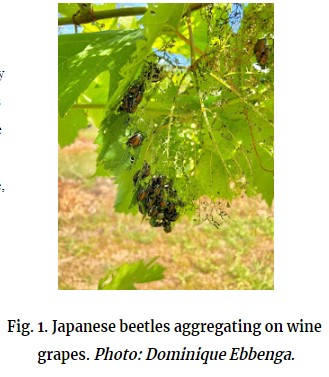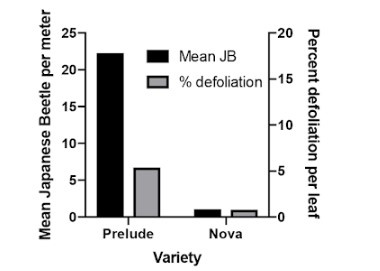By Dominique Ebbenga, Eric Burkness, Matt Clark & Bill Hutchison
Japanese beetle (Popillia japonica) is an invasive species first detected in Minnesota in 1968. While the insect has been in Minnesota for about 50 years, its population density has been relatively low statewide, with significant numbers building in just the past 3-5 years. In recent years, Japanese beetle (JB) populations have been increasing significantly, primarily in the southeast, south-central regions of the state, but particularly in the 7-country metro.

Fruit and growers have noticed heavy infestations on a variety of crops, including: raspberry, blueberry, apples, plums and wine grapes. The recent “onslaught” of JB on these crops has raised new concerns and questions such as:
What economic or “action” thresholds are available for growers to use in making management decisions? Are there biological control options available for JB? What insecticides or organic options are available?
UMN Entomologists Study Japanese Beetles
New research proposals are being submitted this winter to begin to answer these and other questions, and then help build sustainable integrated pest management (IPM) solutions. In the meantime, however, our research and extension team has been active in collecting preliminary data during 2017-2018, to begin to address some of the IPM questions.
In this article, we present some encouraging results regarding varietal differences in resistance to JB that can be useful in helping growers plan ahead with variety selection.
Long summer feeding period
Despite having only one generation per year, our observations for 2018 indicate that the JB adult emergence and survival period is quite extensive, beginning in late June and extending to mid- September (e.g., Rosemount, UMORE Park location, Dakota Co.), suggesting that most crops fruiting during this period will be susceptible.
We will provide more updates on JB biology relevant to fruit crops in future articles. JB adults injure plants by feeding between leaf veins, resulting in a “skeletonizing” appearance to the leaves (Fig. 1). Adults cause most of the damage to fruit crop yield and quality, by either feeding on leaf tissue – that could result in longer-term yield impacts – or by direct damage to developing berries, rendering the fruit unmarketable in most cases.
Which varieties do Japanese beetles prefer?
With >300 known host plants, including non-crop hosts such as wild grape, JB can be very opportunistic in colonizing several crops throughout the summer months, and moving from wild grape, or nearby linden trees, to feed on commercial fruit crops.
In 2018, we evaluated JB feeding damage on several raspberry and wine grape varieties grown in Minnesota. These studies aimed to quantify mean density of JB adults present (meter-row samples), and the corresponding mean percent defoliation (per leaf basis). Two popular summer raspberry varieties, ‘Prelude’ and ‘Nova,’ were screened for JB.

Click here to see more...